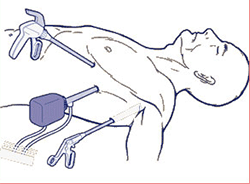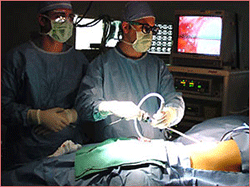Video Assisted Thoracoscopic Surgery (VATS)
Thoracoscopy, the introduction of an illuminated tube through a small incision made between the ribs, was first used in 1910 by Hans Christian Jacobeans for the treatment of tuberculosis. This allowed the surgeon to visualize structures inside the chest and to perform simple procedures. Visibility was generally limited to the surgeon until the development of video-endoscopic equipment which allowed the entire operating team to view and assist in the operation.


Advantages of (VATS) Video – Assisted Thoracic Surgery
Compared to a traditional open chest procedure, VATS has reduced the amount of chest wall trauma, deformity, and post-operative pain. While an open procedure generally requires a 30-40 cm incision, video-assisted biopsies can be performed through three one-cm ports (Figure 1), and a VATS lobectomy, a resection of one lobe of the lung, is performed using a 5-8 cm incision. With this approach, lung biopsies, pleural biopsies, lung surgery, lymph node biopsy etc can be performed with minimal discomfort to patients (Figure 2).
 Ask Doctor
Ask Doctor